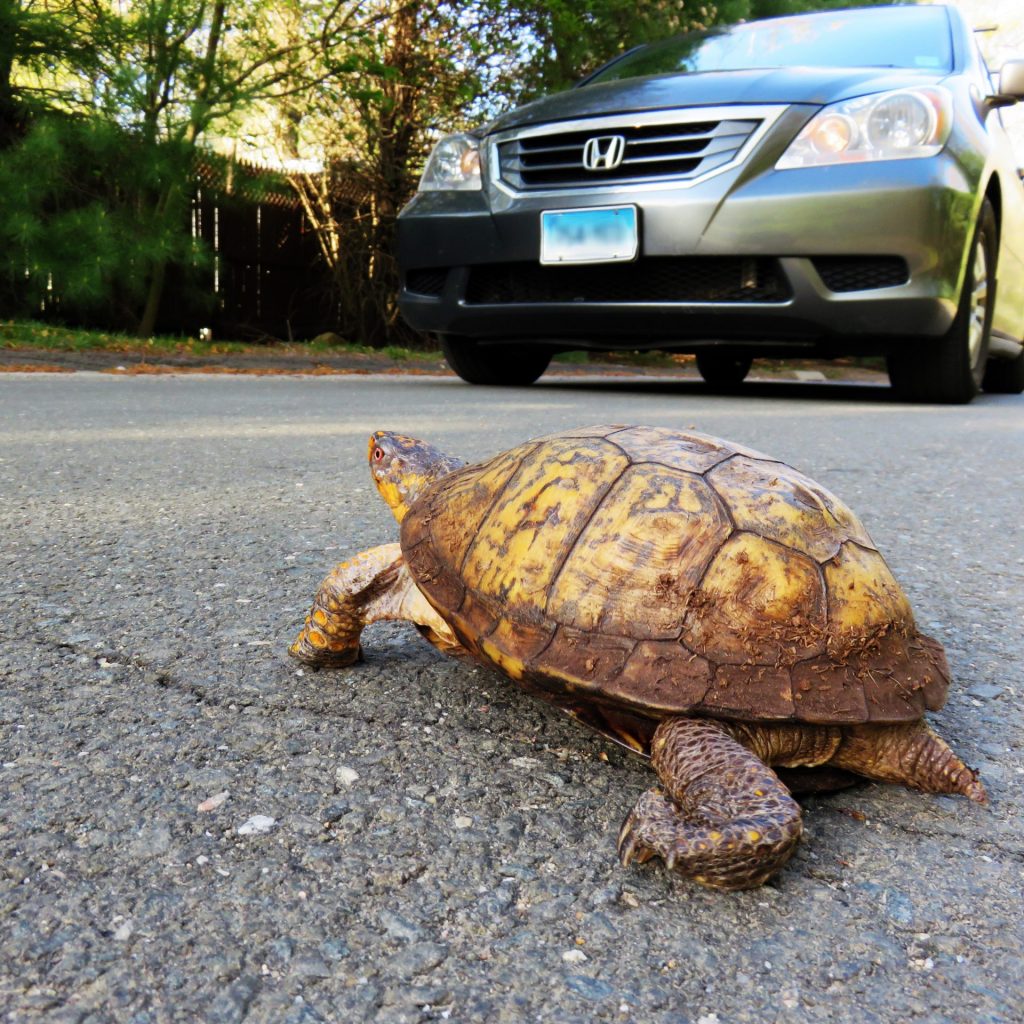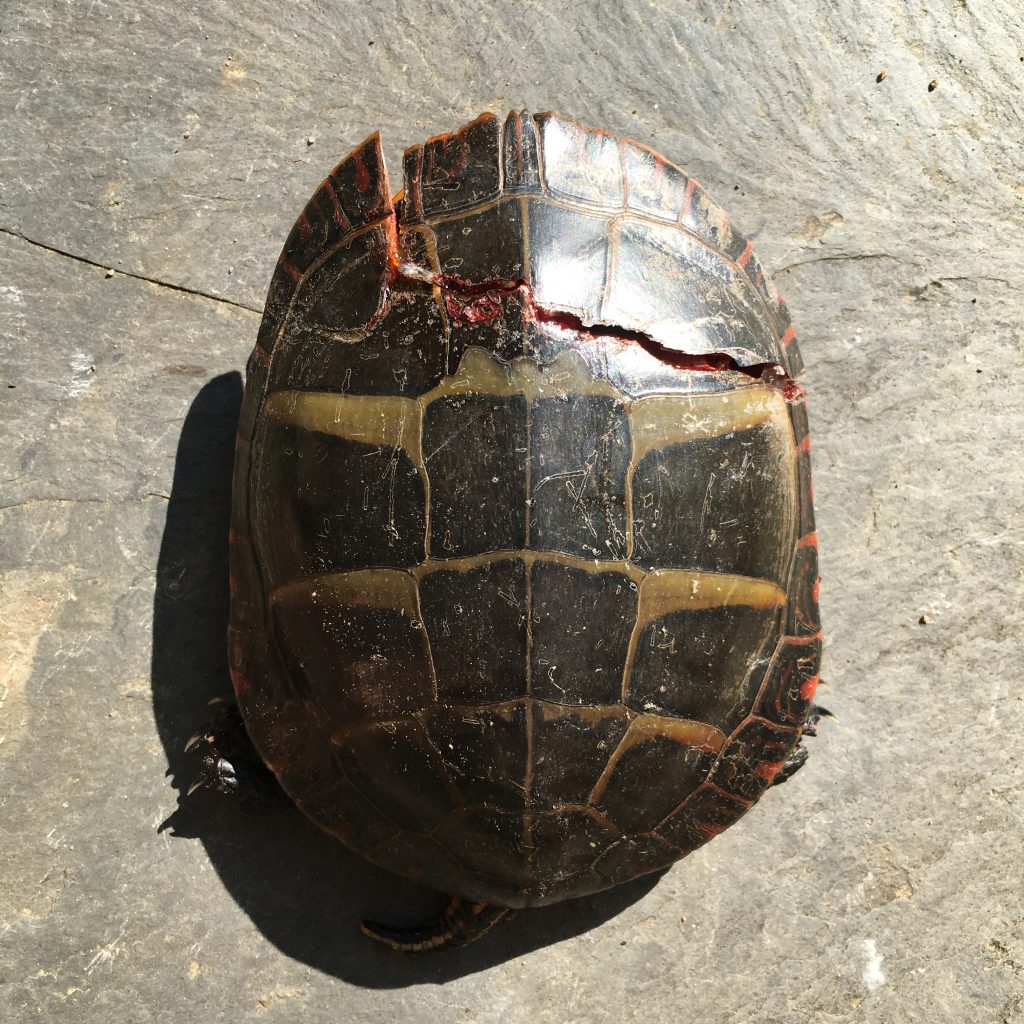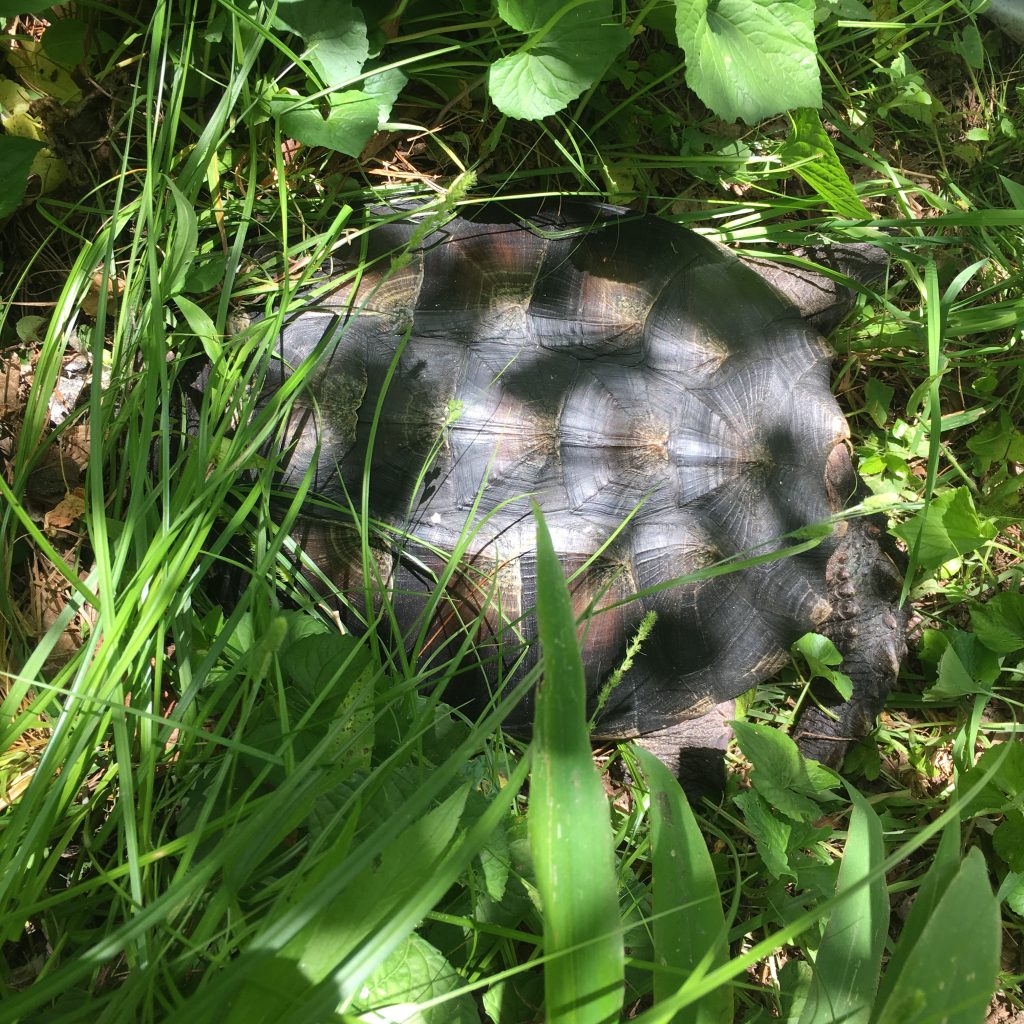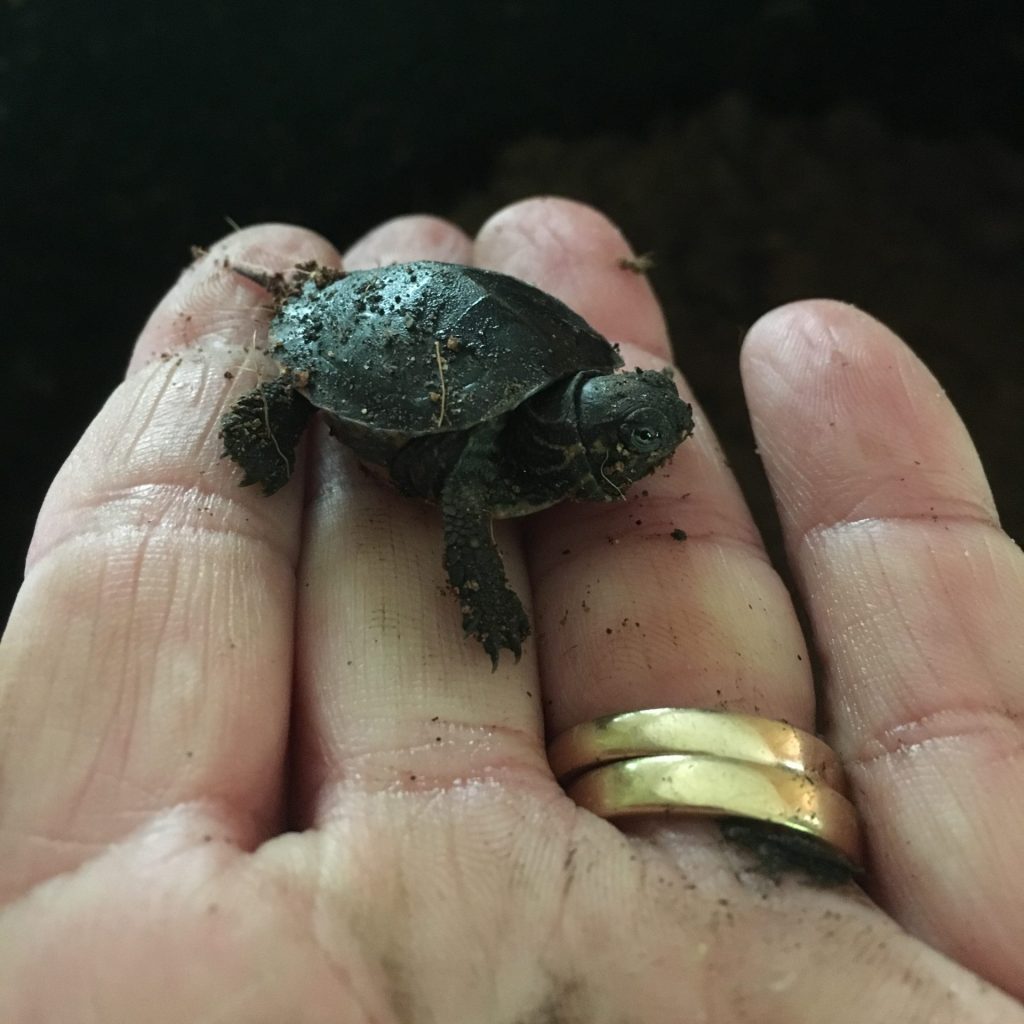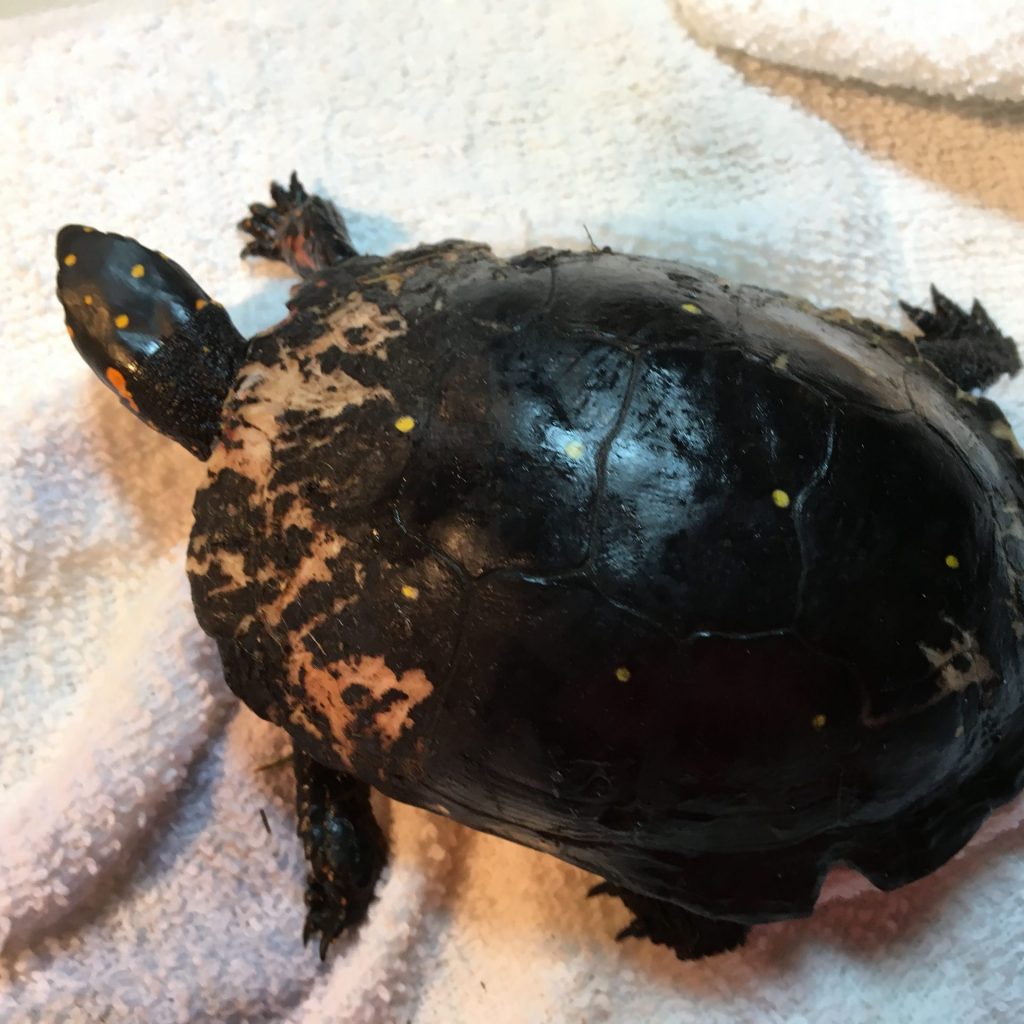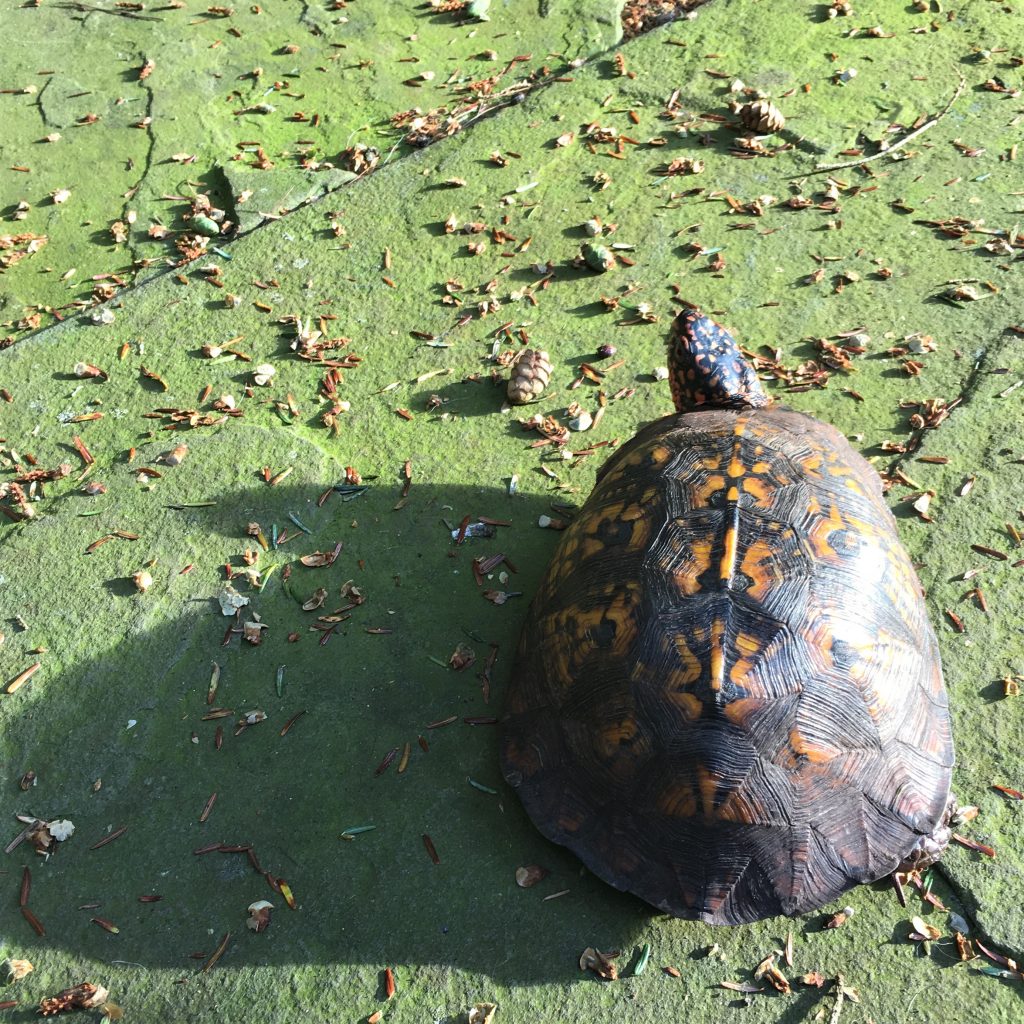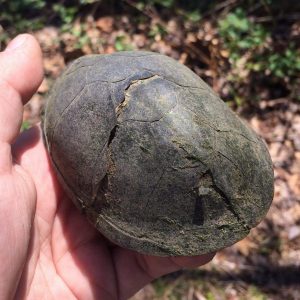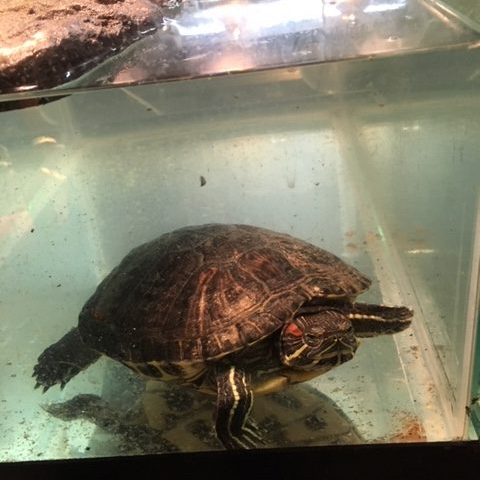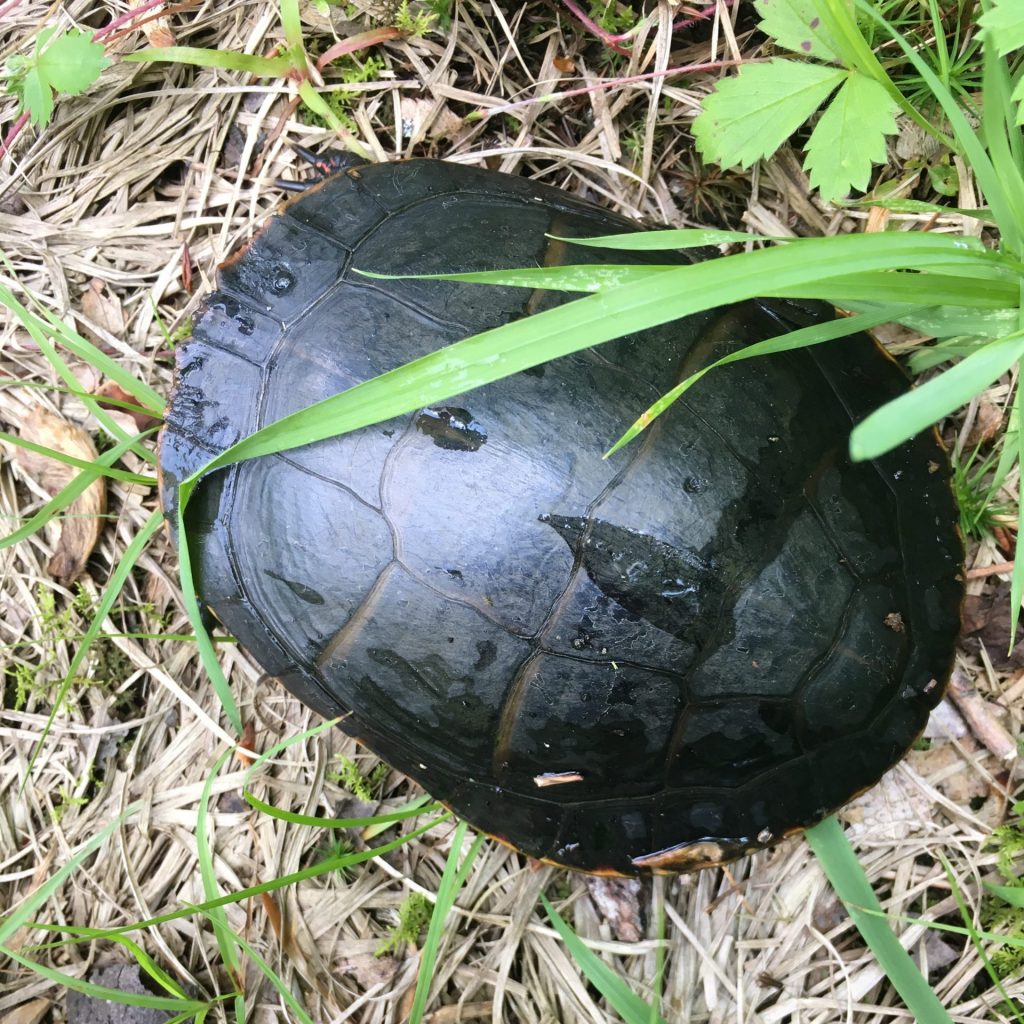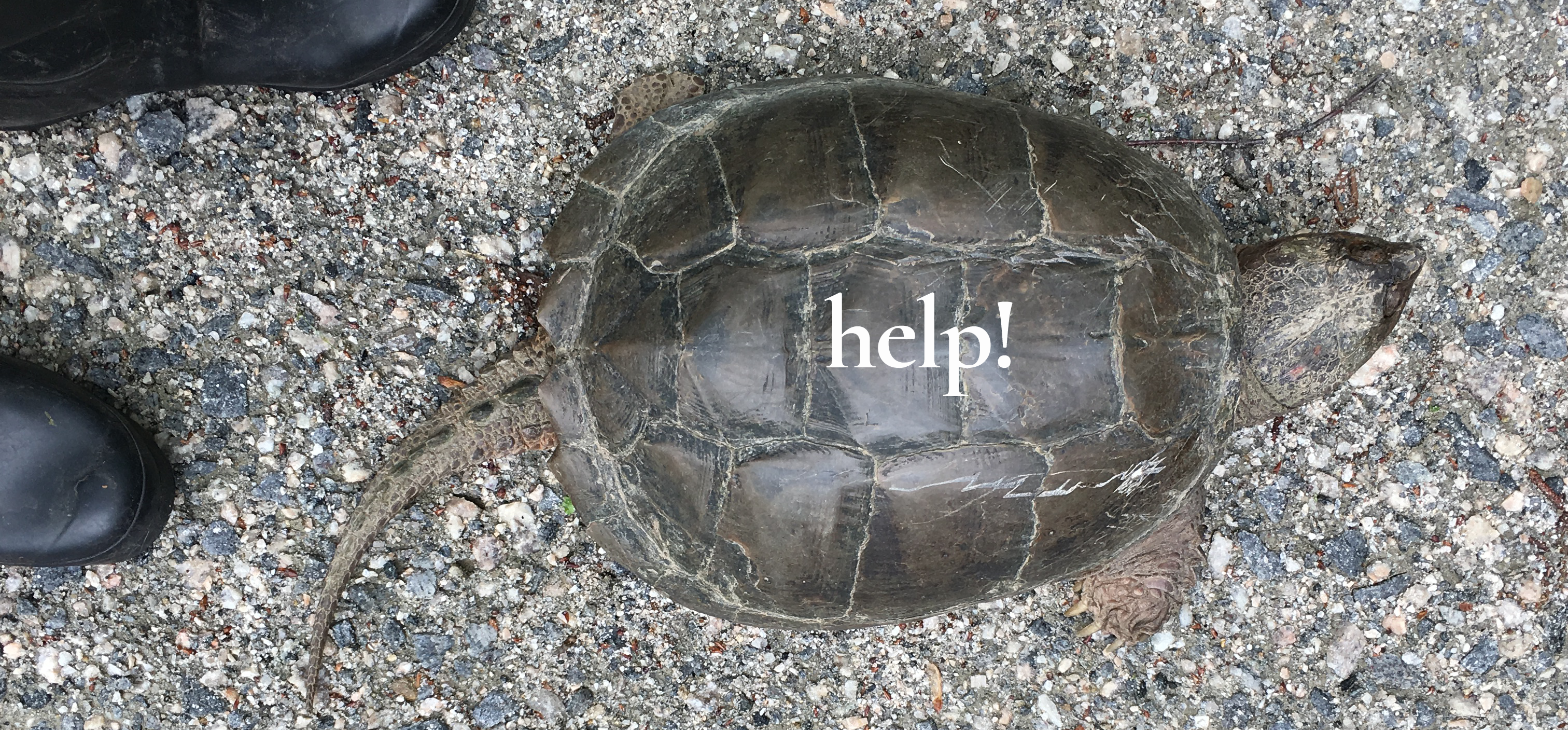
What should I do if...
I found a turtle crossing the road!

Always stop to help any turtle in a roadway if it’s safe to do so! Pull over to the side of the road, put your flashers on, and help the turtle get to the side of the road it’s headed toward. Never put the turtle back on the side it came from; it has a destination in mind and will just head back into the street to try to get where it’s going. If you’re not sure which direction it was going, pick a side and wait to see if it keeps going that way or turns around. If it turns back toward the road, put it on the other side. If you can, always wait to make sure it keeps moving away from the road before leaving it. Snapping turtles can be safely moved by coaxing them onto a car mat or towel and dragging it to the side of the road. NEVER pick up a snapper by the tail–you could seriously damage its spine. Click HERE to see how to safely pick up a snapper!
I found an injured turtle!
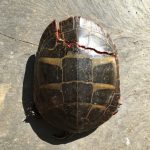
Never leave any injured turtle behind! Turtles are reptiles, and their biology is very different than other animals. Minor injuries can be fatal, but serious injuries that look fatal often heal. If you find an injured turtle, do NOT put it back in the water or leave it behind; take it with you! If you leave and come back for it, chances are that it will have disappeared or it will be dead. Put the turtle in any container you can and make absolutely sure that it’s covered to prevent flies from getting to it—maggots are a huge risk factor for injured turtles. Do not offer it food, water or heat. Contact us or an experienced turtle rehabilitator immediately and let us know what species it is, exactly where you found it, and in which direction it was headed. Photos are always helpful!
There's a huge snapping turtle in the way!
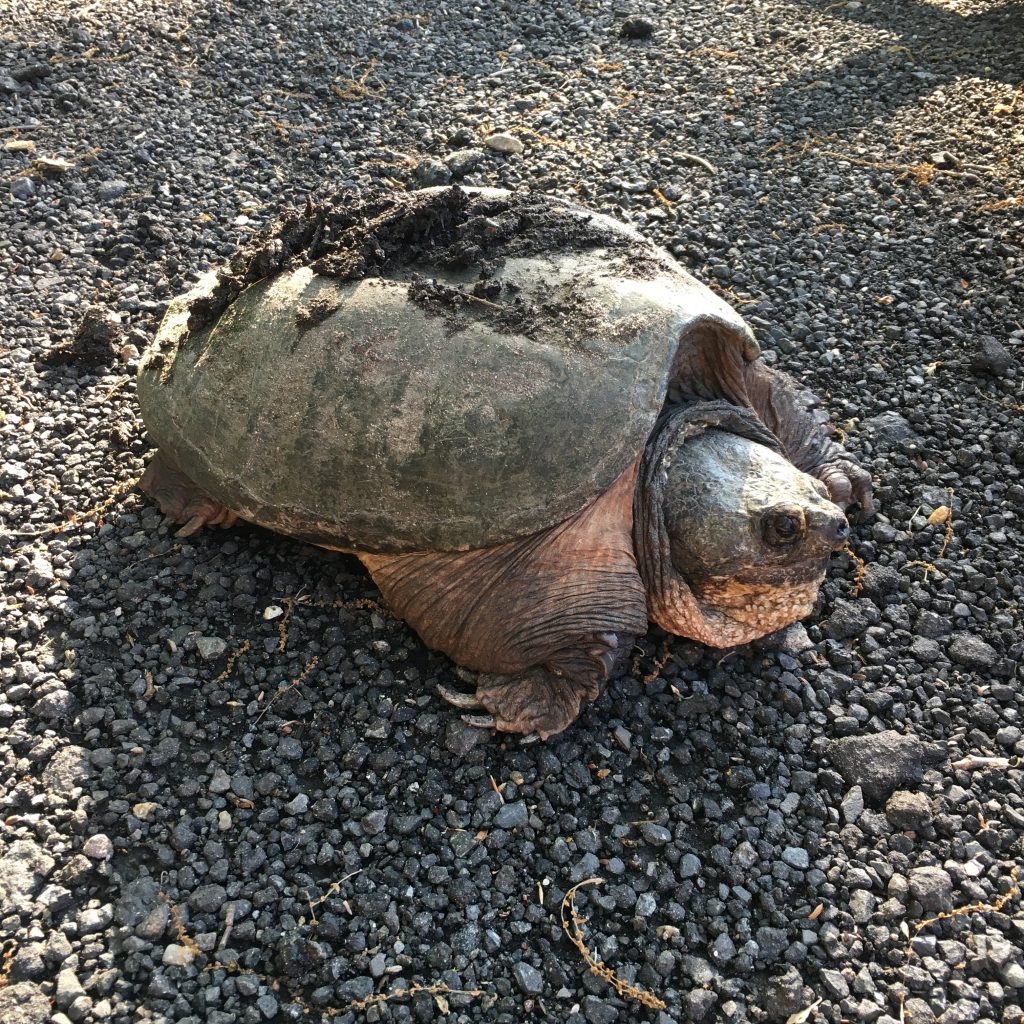
Take a deep breath; that old turtle means you no harm, and is definitely more stressed by you than you are by it! It’s simply trying to get somewhere it has probably been going every year for most of its very long life, stopped to take a break or became frightened, and just wants to be left alone. If it doesn’t feel provoked, it won’t feel the need to act defensively. If it IS being provoked, make sure you do what you can to stop the harrassment…for everyone’s sake! Approach the turtle from behind. If it does snap at you, the snaps will most likely be short warning jabs, but snapping turtles have long necks, so keep your distance from that face. There are several safe ways to move a large, heavy turtle: click HERE to find out how. In the meantime, consider yourself lucky for having met one of the earth’s oldest creatures in person!
I dug up a turtle nest!
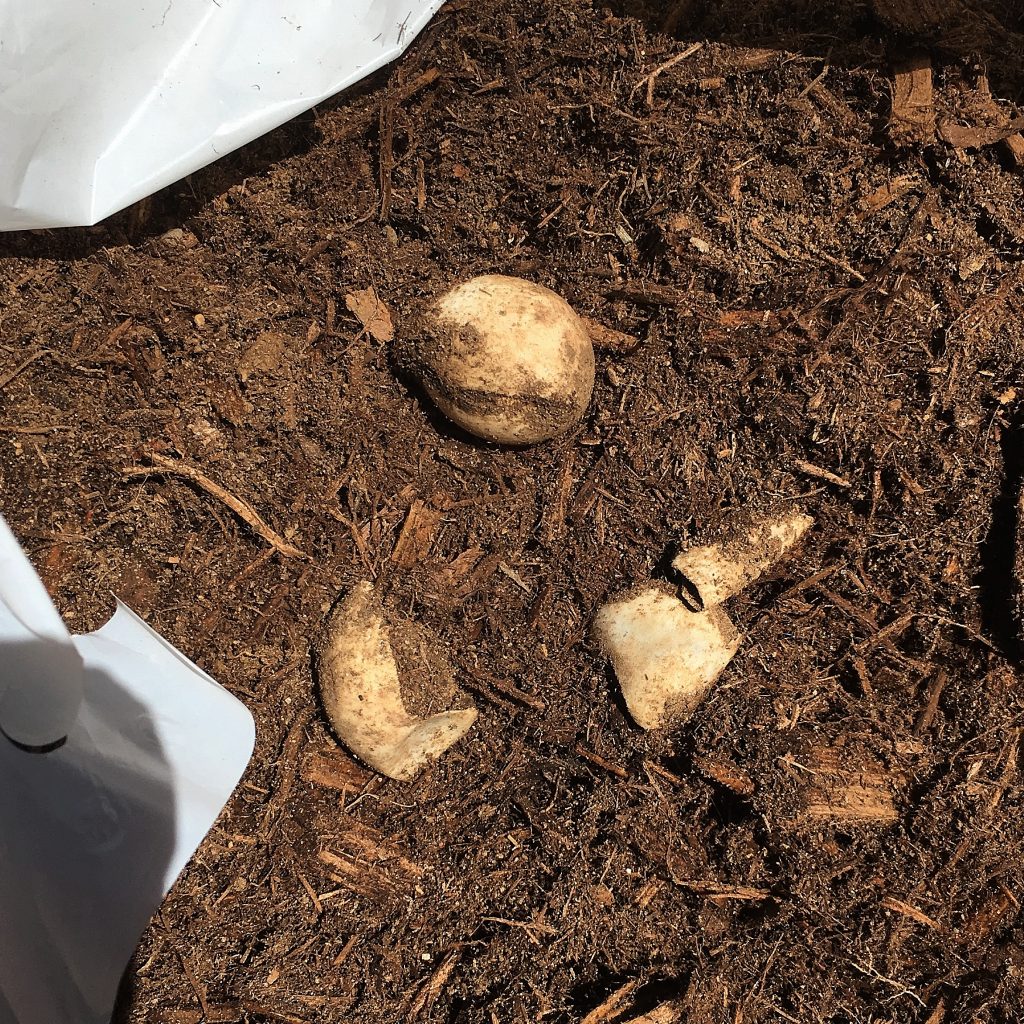
It’s common for people to find eggs in mulch or topsoil piles, or even in their yards and gardens. Turtles love soft, loose, warm substrates in which to lay their eggs, and are pretty stealthy about doing so. If you discover ping-pong-like balls in your dirt or mulch, they’re almost certainly snapping turtle eggs. If the eggs are more oval-shaped, they could belong to a painted turtle or one of several other species. Either way, STOP digging! It’s critical that turtle eggs remain in EXACTLY the upright position in which they were laid; rotating them can kill the embryo inside. Now that you’ve disturbed the nest, you won’t be able to recreate the perfect conditions that mama turtle did, so don’t try to rebury the eggs. Get a bucket and put some of that soil or mulch into it, then very carefully place each egg in the bucket. You won’t be able to tell which way the ones you already dug up were oriented, but the ones you haven’t moved yet must be kept upright, so mark the top of each egg with a little dot or X, using something non-toxic like a pencil, and carefully lift the eggs into the bucket without tipping it AT ALL. Cover the eggs with a little more soil or mulch and get them to a rehabilitator for incubation. Not all turtle eggs are viable, but most will probably hatch by the end of the summer.
There's a snapper in my yard!

Lucky you! You get to observe a dinosaur up close! Snapping turtles are one of the most primitive reptiles still alive, and although they look kind of scary and have a reputation for being dangerous, they’re actually neither. All they want is to be left alone to go about their business which, if they’re on land, is generally just mating or nesting. It’s not unusual for a nesting turtle to hang around for a couple of days while she looks for just the right spot to lay her eggs, and as long as you don’t bother her, she certainly won’t bother you. She has better things to do. So don’t move the turtle–you may disrupt its reproductive process. If you’re lucky enough to have your yard be chosen as the nest site, you may look forward to having that turtle visit you every year! And that’s actually a gift. So simply keep your dog and kids at a safe distance and enjoy watching a creature that’s been on this earth for millions of years do its thing. It will soon be on its way. For more information about snapping turtles, click HERE.
A turtle is nesting in my yard!

Turtle eggs need warmth to incubate, and lawns and gardens often provide the perfect habitat. Many species travel long distances to find the perfect spot with just the right soil for those eggs. If your yard is chosen, great! There’s no need to panic or call someone to remove the eggs unless they are in imminent danger—for instance, if the nest is laid where you plan to have septic work done or in the middle of a gravel driveway, in which case you should call a rehabilitator. Otherwise, don’t worry about fertilizers, chemicals, mowing or your dog digging up the nest; just let nature take its course. What you CAN do, however, is to protect the nest from other predators like raccoons, skunks and foxes. Just get a piece of sturdy wire mesh a few feet across and stake it down securely over the nest spot. Make sure you pay attention to where the eggs were actually laid, because turtles are masters of camouflaging their nests! Leave the mesh in place for a month, then be absolutely sure to remove it, or the emerging hatchlings could be trapped in place and die in the sun. Keep your eyes open for baby turtles, but don’t be surprised if you don’t see them; once they hatch they’ll either disappear quickly as they head back to their mother’s wetland, or they’ll remain underground in the nest for the winter. Whatever you do, DO NOT attempt to dig up that nest to see if the eggs hatched! This process has been going on for millions of years without human interference, so unless the nest is in a dangerous spot, let’s trust those turtles to know what they’re doing.
I found a baby turtle!

Just like sea turtles, fresh water turtles are on their own when they hatch. They have the instinct to head for home, but occasionally a hatchling will struggle along the way or get off course. If the turtle seems dehydrated, lethargic or in any way abnormal, or if outside temperatures have fallen below 60° F, call a rehabilitator immediately. Otherwise, while it’s typically best to leave well enough alone and trust that the turtle knows what to do, the fact is that the survival rate of baby turtles is less than 1% and we humans have created many of the roadblocks along their way. So there’s nothing wrong with helping a baby get to where it’s going. Just make sure you take it to the most appropriate place. How? First, make sure you can identify what species it is, since each requires a very specific type of habitat, and taking it to the wrong place could be fatal. For help with ID, click HERE. Second, locate the nearest body of water that’s appropriate for that species; chances are that its mother came from there. Google Earth is a good resource, or call a rehabilitator for help. Third, be sure to find the right spot to release the turtle. Babies are not good swimmers yet but are a tasty snack for many other animals, so they need shallow water full of plants and mud where they can hang onto things and hide. Release the hatchling at the edge of the water and watch to be sure it swims safely away to hide. If it doesn’t, or if it in any way seems off, take it to a rehabber for evaluation.
My dog caught a turtle!
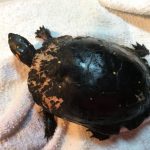
Some dogs like to play with turtles they find, while others will take out a quarter of the turtle in one bite. Hopefully you rescued the turtle from your dog’s mouth before too much damage was done. But if you see ANY sign of damage to the turtle—even just superficial damage—call a rehabilitator right away. As the dog’s owner, you are essentially responsible for the injury, so please be prepared to make a donation to the rehabilitator, if at all possible, since that turtle will almost certainly require antibiotics. Most importantly, take steps to insure that it doesn’t happen again! Even if you have to restrain your dog, it’s temporary: this is primarily just a nesting season issue because that’s when turtles are out and about on land, so late May through mid-July is the critical time.
I found a box turtle in a bad spot!

A story we often hear as rehabilitators is that a well-intentioned person “rescued” a box turtle by taking it home and letting it go in their woods. If there’s one thing you need to know about box turtles, it is that they CANNOT BE RELOCATED. They are homing animals and imprint on their habitats, so trying to move one to a “safer” spot may well end up triggering an endless wandering spree, placing the turtle back into harm’s way as it crosses roads and lawns, bringing it into contact with cars, mowers and dogs. It may possibly even starve to death. Always leave a box turtle where you found it, heading in the direction it was heading. If you feel that doing so really is a death sentence, call a rehabilitator, who can help you assess the situation and figure out the best plan for the turtle.
I found a turtle with old injuries!

It’s not unusual to come across a turtle in the wild—say, on a hike—that appears to be injured but is behaving normally and shows no sign of blood. As reptiles with slow metabolisms, turtles take a long time to heal but do recover from pretty horrific injuries that other animals would succumb to. Whether it’s a shell fracture, a broken beak or missing limb, turtles carry the scars of old injuries with them and do just fine. So before you call a rehabilitator, take a good look at those apparent wounds. If you’re not sure, by all means call! But if it’s pretty clear that the turtle has been getting along fine with them for some time, just let it go on its way.
I want to rehome my pet turtle!

This is perhaps the most common call we get as turtle rehabilitators and, unfortunately, the one we are least able to help with. As wildlife rehabilitators, our job is to care for the wild, native species. Unless they fall into that category and were illegally taken from the wild, pet turtles are not something we normally help with. It’s a tough line to draw, since exotics like Red Eared Sliders are among the most abandoned pets in the country, organizations that rescue and rehome them are few and far between, and of course we would love to help any and all turtles everywhere! But taking in and caring for them only detracts from our ability to care for our wild patients, some of whom are endangered species. Whether it’s the expense of housing and feeding them, the time it takes to care for and clean them, the space they take up in our facilities (most are large turtles requiring quarantine), or the effort that goes into finding homes for them, they place a heavy burden on our limited resources. Occasionally we know of someone looking for a turtle to adopt, so it’s always worth asking. But the best thing you can do is figure out a way to keep that turtle, or find a friend who wants it! Check online resources for better information about how to more easily manage its care; it’s often just a matter of a larger tank with a better filter. Whatever you do, NEVER release it into the wild! Exotics carry pathogens that can spread disease among wild turtles and wipe out fragile populations altogether.
I found a turtle far from water!

Unless the turtle seems sick or has been in the same spot for more than a day without moving, there’s nothing to worry about. Turtles leave the water for many reasons, from mating to nesting to searching for a place to hibernate or even just a new wetland to call home. And they are quite capable of travelling long distances to do so. Take the opportunity to observe this cool creature up close, but only disturb it—and call a rehabber—if there’s something obviously wrong.


